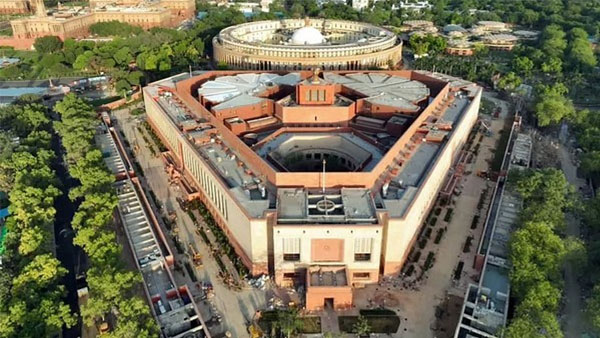By Dipak Kurmi
When the Indian Parliament passed the Bill for the establishment of an Indian Institute of Management in Guwahati, it was not merely the sanctioning of another academic campus but a historic event that reverberated far beyond Assam’s borders. It marked the fulfilment of a long-cherished aspiration, one that generations of people in Assam and the wider Northeast had carried in their hearts. The decision, backed with a financial grant of Rs 550 crore, has become more than a policy announcement; it is a defining milestone that promises to reshape the intellectual, economic, and cultural trajectory of the region. For Assam, it is a moment of vindication, of seeing a dream move from the realm of rhetoric to reality, from aspiration to achievement. For the Northeast, it is a step towards rebalancing the educational map of India and erasing the perception of peripherality that has long shadowed this resource-rich but neglected part of the country.
Assam’s relationship with education has always been rooted in historical depth. The region’s intellectual traditions go back to medieval centres of learning attached to monasteries and satras, where philosophy, literature, and cultural thought flourished under the Vaishnavite reform movement. In the modern period, Cotton College, founded in 1901, became a beacon for higher learning, producing a steady stream of reformers, writers, and administrators who played pivotal roles in shaping the state’s identity. Gauhati University, established in 1948, nurtured a generation of post-Independence youth, embedding the ideas of scholarship and nation-building in the soil of Assam. The arrival of the Indian Institute of Technology Guwahati in 1994 was another watershed moment, placing Assam firmly on the country’s technological and scientific map. Yet, amid these achievements, there remained a persistent void—the absence of an Indian Institute of Management. In a world driven by managerial expertise, entrepreneurial vision, and leadership skills, Assam’s lack of an IIM was both symbolic and practical. It denied the youth of the region access to the kind of education that empowers leaders to innovate, manage industries, and engage in global competition.
This absence was not just about infrastructure but about recognition. The IIM brand is globally acknowledged as a crucible of leadership, its alumni shaping economies, corporations, and governments across the world. The absence of such an institution in Assam long conveyed an unspoken message that the Northeast was peripheral to India’s imagination of modernity. The passage of the Bill therefore represents more than an educational expansion—it is a rectification of history, an act that brings Assam into parity with other regions and acknowledges its rightful place in India’s intellectual landscape.
The Northeast is often described in paradoxical terms. It is a land of breathtaking biodiversity, extraordinary cultural wealth, and immense natural resources, yet it has been burdened by uneven development, infrastructural neglect, and socio-political unrest. Its youth are renowned for their creativity, adaptability, and resilience, yet countless numbers migrate to Delhi, Bengaluru, Pune, and other metropolitan centres in search of opportunity. Its geography places it at once on the frontier and at the crossroads of South Asia and Southeast Asia, but this position has not been fully harnessed into strategic advantage. The establishment of IIM Shillong in 2008 was an important milestone, yet it was not sufficient for the educational, demographic, and economic needs of the entire region. A second IIM became a necessity, and given Assam’s status as the largest and most populous state of the Northeast, Guwahati was the natural choice.
Guwahati today is no longer merely the administrative capital of Assam. It has become the commercial hub, the cultural nerve centre, and the educational axis of the region. Its rapid urbanisation, its connectivity with the rest of India, and its proximity to Southeast Asia through the Act East Policy make it the ideal host for an institution of such stature. By situating an IIM here, the government has in effect recognised Guwahati not only as a city of the present but also as a city of the future—a city that will serve as the anchor for regional aspirations while extending India’s educational and economic outreach eastward.
In this achievement, the role of Assam’s Chief Minister Dr Himanta Biswa Sarma is pivotal. Few political leaders in recent memory have pursued the transformation of education with the same persistence and vision. From his earlier tenure as Education Minister to his present role as Chief Minister, Dr Sarma has consistently articulated the centrality of education in Assam’s development story. His efforts have ranged from expanding medical colleges across districts to upgrading universities, from strengthening school infrastructure to facilitating the establishment of premier institutions such as AIIMS Guwahati. His advocacy for IIM Guwahati was not a sporadic effort but the culmination of years of persistent engagement with the Union Government. His vision is clear: to position Guwahati as the intellectual capital of the Northeast and to ensure that the state ceases to be a mere supplier of human capital to other parts of India but becomes a destination where talent converges.
The establishment of AIIMS Guwahati, the expansion of IIT Guwahati, and now the approval of IIM Guwahati are not isolated achievements but interconnected strands of a broader strategy. They represent an ecosystem where higher education, healthcare, research, and innovation can thrive in synergy. Dr Sarma’s ability to attract top professionals to Assam and his focus on creating conditions conducive to talent retention will be crucial for the success of the new institution, especially given the chronic challenge of faculty shortages that even older IIMs continue to face.
What makes this development particularly significant is its regional dimension. IIM Guwahati is not merely an institution for Assam; it is for the entire Northeast. Students from Arunachal Pradesh, Manipur, Mizoram, Nagaland, Tripura, and Meghalaya will converge here, creating a shared academic space that strengthens the threads of regional unity. In an area where ethnic and political fault lines have often hindered integration, the idea of a shared centre of excellence carries deep symbolic value. It will nurture not only academic collaboration but also cultural exchange and inter-state solidarity.
The financial grant of Rs 550 crore, sanctioned for the establishment of IIM Guwahati, is more than a budgetary allocation—it is a statement of intent. Building an IIM is not limited to erecting classrooms and dormitories; it is about constructing a crucible of ideas, a laboratory of leadership, and a workshop of entrepreneurship. To succeed, the institution must invest in world-class infrastructure, attract faculty of the highest calibre, and develop a curriculum that is globally aligned while being locally responsive. The Northeast is a region with unique developmental challenges—ecological fragility, rural entrepreneurship, cross-border trade opportunities, and cultural diversity. A truly visionary IIM Guwahati will incorporate these dimensions into its pedagogy, thereby producing managers and leaders who are not only prepared for corporate boardrooms but also for solving the pressing challenges of the region.
The economic implications of this development are profound. Educational institutions of such stature act as engines of growth rather than ivory towers. They stimulate local economies through the inflow of students, faculty, and staff. They generate demand for housing, services, and businesses. They act as incubators for start-ups, consultancy firms, and think tanks. The potential synergy between IIT Guwahati and IIM Guwahati is particularly promising. Together, these institutions can foster collaborations where technological innovation meets managerial expertise to create globally relevant solutions. From agro-industries and tourism to healthcare, information technology, and cross-border commerce, the scope for partnership is immense.
Equally important is the symbolic transformation this institution represents. For decades, the Northeast has lived with a sense of marginalisation. Insurgency, infrastructural neglect, and lack of opportunities have contributed to a feeling of exclusion from India’s developmental imagination. The establishment of IIM Guwahati, alongside IIT and AIIMS, sends a powerful counter-narrative: that the Northeast is not peripheral but central to India’s vision of the future. For the youth of the region, this recognition is more than an opportunity; it is an affirmation of dignity, belonging, and value. It tells them that their homeland matters, that their aspirations are acknowledged, and that their future can be rooted in their own soil rather than being realised only in distant metropolises.
Yet, the road ahead demands vigilance and integrity. Grand announcements risk losing momentum if not backed by efficient implementation, transparent utilisation of funds, and a commitment to excellence. The success of IIM Guwahati will depend on the quality of its faculty, the robustness of its industry linkages, the inclusiveness of its curriculum, and its ability to engage with the region’s challenges. Chief Minister Dr Himanta Biswa Sarma’s continued leadership will be crucial in ensuring that the momentum does not wane. His vision must be matched with effective execution, constant monitoring, and accountability.
The orientation of the institute will also determine its legacy. If it becomes merely a replica of other IIMs without contextual sensitivity, it risks irrelevance in addressing regional issues. But if it integrates sustainable development, rural entrepreneurship, ecological conservation, and cross-border trade into its framework, it could emerge as a model institution that is globally competitive yet deeply rooted in local realities. In doing so, it could redefine the very role of management education in India.
The history of Assam’s educational journey demonstrates how institutions shape destiny. Cotton College became the lighthouse of modern higher education in the Brahmaputra Valley. Gauhati University emerged as the intellectual crucible of post-Independence Assam. IIT Guwahati placed the state on the technological map, while AIIMS Guwahati is transforming healthcare and medical education. IIM Guwahati is now poised to join this lineage, carrying forward the legacy into the domain of management, leadership, and entrepreneurship. That all of this has been achieved during the tenure of Chief Minister Dr Himanta Biswa Sarma underlines the convergence of historical demand and political will.
In the final analysis, the passage of the Bill to establish IIM Guwahati is not a routine legislative act; it is a landmark turning point in the history of Assam and the Northeast. The Rs 550 crore grant is not just a financial provision but a promise of transformation. Dr Sarma’s initiative is not merely a political gesture but a long-term commitment to the future of Assam and the Northeast. For the youth of the region, IIM Guwahati will not merely be a campus rising on the banks of the Brahmaputra but a symbol of opportunity, recognition, and empowerment.
The journey ahead will not be without challenges, but if pursued with sincerity, vision, and determination, IIM Guwahati has the potential to emerge as one of the finest examples of how education can serve as the cornerstone of empowerment, integration, and progress. For Assam and for the Northeast, it could well signal the beginning of a new chapter—one where aspirations are no longer compelled to migrate but take root at home, where excellence is not the exception but the norm, and where the region’s rich cultural and natural wealth finds resonance in its academic and entrepreneurial achievements.
(the writer can be reached at dipakkurmiglpltd@gmail.com)




